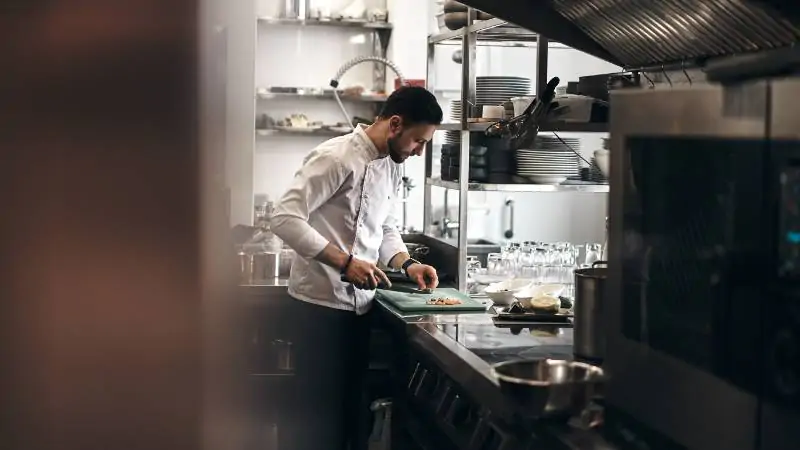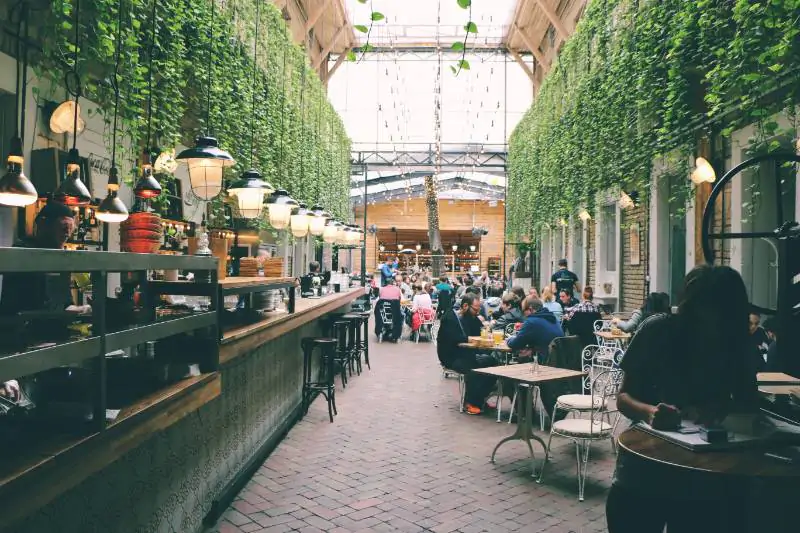Sustainable restaurants: How can restaurants be more eco-friendly?


Sustainability has become a pressing global concern over recent years for businesses across the spectrum, and the food industry is no exception. From energy costs to restaurant food waste, sustainability in the hospitality industry is crucial for both reducing the carbon footprint of the industry and appealing to the needs and desires of consumers. This coincides with the desires of many hospitality business owners too, with 70% of restaurant owners claiming that improving sustainability is one of their top priorities (Simplot).
But just how important is sustainability in the hospitality industry, and how can restaurants be more sustainable? In this guide, we’ll explore a range of restaurant sustainability practices to help you make your establishment more environmentally friendly, from reducing food waste to choosing the most eco-friendly kitchen appliances. Whether you own a fine dining establishment or a fast food restaurant, this guide will provide you with useful insights and practical tips to help you reduce the negative environmental impact of your food business.
The importance of sustainability in the hospitality industry
The importance of restaurant sustainability to consumers
Reducing food waste in restaurants
- How to reduce food waste in restaurants with an audit
- Making the most of your ingredients
- Other ways to reduce food waste in restaurants
Choosing environmentally friendly ingredients
Creating a sustainable commercial kitchen
- How the right equipment can improve the sustainability of your restaurant
- The importance of cleaning and caring for your appliances
Other ways to improve sustainability in the hospitality industry
The importance of sustainability in the hospitality industry


We all understand the importance of becoming more sustainable, in both our businesses and our personal lives. But as a food business owner, there are a number of reasons your restaurant in particular should work on becoming more sustainable.
The environmental impact of food businesses
The hospitality industry has a significant impact on the environment. In fact, according to the UN, food systems account for a third of global greenhouse gas emissions. When it comes to restaurants in particular, research from Zero Foodprint has found that an average of 8kg of CO2 is emitted per restaurant meal. There are various factors and practices in food businesses which can have a negative environmental impact — below are just a few of the main areas where restaurants are impacting the environment.
Restaurant food waste
Food waste is very common in restaurants, and while a small amount is to be expected, many hospitality businesses are wasting an excessive amount which has a negative environmental impact. When this food waste is sent to landfill and left to rot, it releases methane which is an especially powerful greenhouse gas. In fact, this pollutant gas has over 80 times the warming power of carbon dioxide (EDF). On top of this, throwing away food wastes the energy that was used to create the food in the first place. Take beef for example — throwing away a kilogram of beef wastes around 50 litres of the fresh water used to produce the meat on average (European Livestock Voice).
But just how much food do restaurants waste? According to Waste & Resources Action Programme (WRAP), it is estimated that hospitality and food services in the UK waste a staggering 1,098,000 tonnes of food per year. Not only does this have a huge environmental impact, but it can have financial ramifications for food businesses too.
Ingredients
Where you source your ingredients from can have a significant impact on the sustainability of your hospitality business. Due to our climate and geographical location, a significant portion of food consumed in the UK is imported. While this can help restaurants offer a varied menu, this also has environmental impacts. A report from the European Commission estimates that global food miles generate almost a fifth of all CO2 emissions from food.
Energy
As any restaurant owner knows, hospitality businesses tend to use a lot of energy. In fact, the catering industry uses around 21,600 million kWh per year in Britain (Carbon Trust). While energy bills will always be a significant cost for restaurants and hospitality businesses, these can often be cut significantly to both lower the carbon footprint of your business and boost your budget. Carbon Trust estimates that with some simple changes in commercial kitchens, the catering industry could save over £250 million in energy costs every year, as well as more than a million tonnes of carbon.
The importance of restaurant sustainability to consumers
Increasing the sustainability of your restaurant is of course important for the planet, but it may well be crucial for your customers too. Diners have become increasingly conscious of their consumption choices, and as a result they often seek dining experiences that align with their values. Deloitte’s Sustainability and Consumer Behaviour Survey 2022 has found that 40% of respondents have chosen a brand based on environmentally sustainable practices. On top of this, a survey by the National Restaurant Association found that 38% of respondents claimed they would be more likely to choose a restaurant that offers locally-sourced foods over one that doesn’t, while 30% said they would choose a restaurant that uses environmentally-friendly grown ingredients over one that doesn’t. So, by adopting eco-friendly practices, restaurants can not only reduce their environmental footprint but also attract a growing market of environmentally conscious consumers.
Reducing food waste in restaurants


Food waste in the restaurant industry is one of the main reasons the sector's carbon footprint is so high, making it the best place to start when it comes to improving sustainability. And the good news is that by having some simple food waste reduction plans in place you may be able to not just reduce wasted ingredients significantly, but improve your business budget too.
How to reduce food waste in restaurants with an audit
One of the best ways to reduce food waste in a restaurant is to prevent it from the source. A good way to start your sustainability journey is by conducting a food waste audit, as this can help you identify areas where food is being wasted and implement measures to reduce this waste. While time-consuming, a successful food waste audit can have a significant impact on both short-term and long-term food waste reduction goals. Follow the steps below to conduct this for your hospitality business:
- Choose a time frame for your audit: Choose a representative period for conducting your audit. This could be a week or a month, depending on the size of your restaurant and the resources available for the audit. It's best to avoid doing this during particularly busy periods, such as during the festive season.
- Form a team: Assemble a team of staff members who will assist in conducting the audit. Include individuals from different departments, such as kitchen staff, servers, and management, to get a comprehensive view of food waste generation.
- Assess: Assess and analyse your current situation and make some preliminary notes for where you think you can improve. This gives you a good overview of the situation and allows you to see if there are any obvious areas you can tackle first.
- Create data sheets: Design data sheets to record the information during the audit. These could include categories like food item, quantity wasted, reason for waste, and potential actions to reduce waste.
- Measure your restaurant food waste: During the audit period, have your team weigh and record all food waste at different stages of food preparation and service. This includes kitchen food prep, plate waste, and unsold or expired items.
- Analyse your data: Once the audit period is over, compile and analyse the data you and your team have collected. Look for patterns and trends in the types of food wasted, common reasons for waste, and peak times for waste generation.
- Identify areas for improvement: Based on your data analysis, pinpoint areas where the most significant food waste occurs. This could be due to overproduction, inefficient storage, or poor portion control.
- Develop an action plan: Create a comprehensive action plan to address the identified issues. This plan should include specific measures to reduce food waste, such as using portion control tools and scales for serving, investing in better storage for ingredients, improving inventory management, or offering smaller portions for certain dishes.
- Implement changes: Put your action plan into practice and communicate the changes to your staff. It may require ongoing training and monitoring to ensure everyone understands what is expected of them.
- Monitor progress: To make sure the plan is effective in the long run, regularly review and assess the impact of the implemented changes. Monitor food waste levels over time to gauge the effectiveness of your waste reduction efforts.
Making the most of your ingredients
Another great way to help your hospitality business reduce food waste is to make the most of every ingredient. It’s easy to use what we consider to be the “best part” of an ingredient and throw away the scraps, but using every part of a piece of food allows you to reduce both your restaurant waste and wasted cash. This can also give your chefs the opportunity to get creative and try out new recipes. Below are some of the most common wasted foods in restaurants, and ideas for how you can turn them into delicious dishes:
- Vegetable scraps: These are incredibly versatile — as well as being ideal for making vegetable stock and vegetable crisps, they can also be added to smoothies, sauces, and even used as salad garnish.
- Fruit: Fruit which may have lost its firmness is still just as delicious when used in smoothies and juices. You can also use it to make jams, desserts, salad dressings, and you can even dehydrate fruit to use as cocktail garnishing.
- Bread: One of the most versatile leftovers, leftover bread can be used to make breadcrumbs, croutons, bread and butter pudding, bread sauce, and much more.
- Milk: If you have leftover milk, ice cream is a great way to use it up. You can also make a white sauce to store in the freezer.
- Eggs: Do you often find you're left with too many eggs to use? Consider preserving them by either whisking and freezing them or dehydrating them.
- Coffee grounds: If you have a garden of produce for your commercial kitchen, coffee grounds are a great fertiliser.
You may find that your current menu doesn’t allow you to make the most of all the food in your commercial kitchen. So why not consider updating your menu? This will allow you to create dishes that incorporate ingredients from other menu items to use them to efficiently reduce wasted ingredients. If you want some tips on doing this, make sure to read our guide to creating a menu.
There are also some useful commercial kitchen appliances available to help you use as much and as many of your ingredients as possible. Dehydrators are particularly useful for this, as they allow your chefs to preserve ingredients. You can find out more about the benefits of dehydrators with our commercial dehydrator buying guide.
Other ways to reduce food waste in restaurants
If you’re looking for even more ways to improve the carbon footprint of your business, the eco-friendly food waste solutions for restaurants below are easy to implement and can have a significant impact on the sustainability of your establishment.
- Training: Educate your employees about the importance of reducing food waste and provide training on best practices for handling, storing, and serving food. Make sure everyone is aware of the goals and their role in achieving them.
- Portion control: Implement portion control measures to ensure that customers receive appropriate serving sizes. Overly large portions often lead to more leftovers on plates.
- Create a food waste friendly menu: Design your menu to minimise waste by offering flexible options for portion sizes or side dishes. You should also look at which menu items aren’t selling as well, as the unused ingredients in these dishes are likely to be wasted.
- Encourage customers to enjoy their leftovers: Even if a customer does not finish their meal in your restaurant, this doesn’t mean they can’t enjoy the rest of the dish in the comfort of their own home. Offer environmentally friendly takeaway containers to customers with food left on their plate and provide them with reheating instructions to help them make the most of their dining experience.
- Collaborate with suppliers: Work with your food suppliers to find a delivery schedule that suits your business and order quantities to reduce the likelihood of overstocking or spoilage.
- Composting: When food does have to be thrown away, establish a composting system for food scraps to reduce the environmental impact.
Choosing environmentally friendly ingredients


It isn’t just wasted ingredients which add to your restaurant’s carbon footprint, but the type of ingredients you use. As we already know, transporting ingredients is a major CO2 contributor in the food industry. But how exactly can you combat this to create a sustainable hospitality business?
Choosing local ingredients
Of course, the best way to reduce the distance your ingredients have to travel is by buying from local producers. Not only is this better for the planet, but it means that you are supporting local businesses and getting fresher food in return. Make sure to do your research to find top-quality local producers near you. Looking online should help you with this, as will asking other food and catering business owners in the area. Another great way to find a local supplier is by visiting a farmers market and chatting to the vendors. This allows you to both learn more about the supplier and see or sample some of their ingredients.
Out of season ingredients tend to have much higher carbon footprints than seasonal produce, as the in-season food won’t have as far to travel. This can also make the ingredients more affordable, and of course, fresher too. So, when updating your menu, it’s worth considering how you can incorporate these ingredients into your dishes. Use the table below to find produce for each season.
| Spring | Summer | Autumn | Winter |
| Artichoke | Apple | Apple | Apple |
| Aubergine | Basil | Blackberry | Brussels sprouts |
| Asparagus | Beetroot | Butternut squash | Cabbage |
| Beetroot | Broccoli | Brussels sprouts | Carrots |
| Carrots | Carrots | Cabbage | Cauliflower |
| Cauliflowers | Cauliflower | Carrots | Horseradish |
| Elderflowers | Celery | Celeriac | Kale |
| New potatoes | Cherries | Kale | Leek |
| Peas | Courgette | Leek | Mushroom |
| Parsnips | Cucumber | Marrow | Onions |
| Radishes | Onions and shallots | Onions | Parsnip |
| Rhubarb | Potato | Parsnip | Pear |
| Rocket | Radish | Pear | Potatoes |
| Spring greens | Raspberries | Potatoes | Pumpkin |
| Spring onions | Rocket | Pumpkin | Rhubarb |
| Sprouting broccoli | Rhubarb | Runner beans | Sprouting broccoli |
| Swede | Runner beans | Spinach | Swede |
| Watercress | Strawberries | Sprouting broccoli | Turnip |
| Wild garlic | Tomatoes | Turnip | Winter squash |
Creating a sustainable commercial kitchen


It isn’t all about the food when it comes to creating a sustainable hospitality business — the equipment and supplies in your commercial kitchen can be very important too. Below we explain just how important it is to choose the right equipment and keep it in the best condition.
How the right equipment can improve the sustainability of your restaurant
Choosing the right appliances and equipment for your commercial kitchen can save you a significant amount of energy, which is great for both the planet and your budget. High-quality kitchen appliances are worth the investment in the long run, as they will most likely last longer than cheaper, poorer quality products. So, make sure to do plenty of research when choosing appliances by looking at reviews and reading buying guides to check the quality of a product. Another good way to ensure the reliability of a product is by shopping from trusted commercial catering brands, such as KitchenAid, HotmixPro, and Dynamic.
When shopping for your equipment, you should opt for a trusted and reliable supplier not just for the security of your purchase, but for the sustainability of your business. Doing so means you are much less likely to receive a faulty product which could end up going to landfill in just a few months' time. If you do experience trouble with your product when buying from a trusted supplier, they are more likely to offer generous return and warranty periods and simply provide you with a better quality of customer service, making it easier to return or fix a faulty product to prevent it from being wasted.
As well as investing in high-quality equipment, you can also make your commercial kitchen more eco-friendly by choosing certain types of appliances. As we’ve already covered, dehydrators are useful when it comes to reducing food waste in restaurants. Food processors can also be a sustainable investment as they are so versatile and can perform a variety of tasks, from kneading to chopping to blending. You can find out more about the benefits of a food processor with our food processor and blender buying guide.
If you’re looking for even more ways to choose the right equipment for your restaurant kitchen, here are even more sustainable appliance shopping tips:
- The brand’s environmental efforts: Some brands do more to protect the environment than others, so consider buying equipment made by sustainable companies. For example, Nemox use ICE GREEN technology when crafting their gelato machines to reduce greenhouse gases.
- Water efficiency: Consider appliances that are designed to use less water. Water-efficient dishwashers, steamers, and refrigeration systems can help reduce water wastage and save money on utility bills.
- Recycling and disposal: Check the manufacturer's policies on recycling and disposal of old appliances. Some companies offer recycling programs or take back old equipment for proper disposal.
- Materials: Opt for appliances made from sustainable and recyclable materials. Stainless steel is a popular choice for commercial kitchen equipment due to its durability and recyclability.
The importance of cleaning and caring for your appliances
Even the highest quality commercial kitchen equipment can become less sustainable if it isn’t cared for well. This is partly down to energy consumption. Properly maintained equipment operates more efficiently, requiring less energy to function optimally. This translates into lower electricity bills, decreased greenhouse gas emissions, and a smaller carbon footprint for your restaurant.
Cleaning and maintaining your appliance can also expand the lifespan of your product, reducing the need for a premature replacement. The manufacturing and disposal processes of kitchen equipment consume significant energy and resources, leading to increased environmental burden. By adopting regular maintenance practices and promptly addressing issues, such as leakages or worn-out parts, you can extend the life of your appliances to reduce the overall environmental impact.
The best way to care for your equipment is to read the manual for each appliance, as this will provide you with the cleaning and maintenance information you need. You may also be able to find more detailed guides online, such as our guide to maintaining a Bonzer can opener.
Other ways to improve sustainability in the hospitality industry


As well as the wide range of methods above, there are a number of other ways you can do good by both the planet and your business. Below are a range of both larger and smaller changes you can implement to ensure your hospitality business is as sustainable as can be:
- Install motion sensor lights to reduce energy usage
- Sell your leftover dishes at a lower price on Too Good To Go to reduce food waste
- Installing low-flow faucets to reduce water usage
- If you do your own deliveries, opt for more environmentally-friendly modes of transport like bicycles or electric cars/motorbikes
- Offer a wider variety of plant-based dishes
- Use sustainable packaging for takeaway dishes
- Opt for eco-friendly cleaning products
- Repair your equipment rather than replacing it by using spare parts to fix your appliances
- Go digital to cut down on paper receipts
- Buy ingredients in bulk to reduce the ingredient miles
- Consider growing some of your own ingredients
Sustainability in the restaurant sector is vital, not just for the future of the industry but for the environment too. With the sustainable restaurant tips above, you should have the knowledge you need to create an eco-friendly establishment to reduce your restaurant’s carbon footprint and appeal to sustainability-driven consumers.
We have a wider range of high-quality and durable supplies here at Mitchell & Cooper for building a sustainable commercial kitchen, from appliances like stick blenders and thermal mixers to kitchenware like can openers and salad spinners. Browse our full collection today, and make sure to check out the rest of our guides for even more hospitality advice and information.
